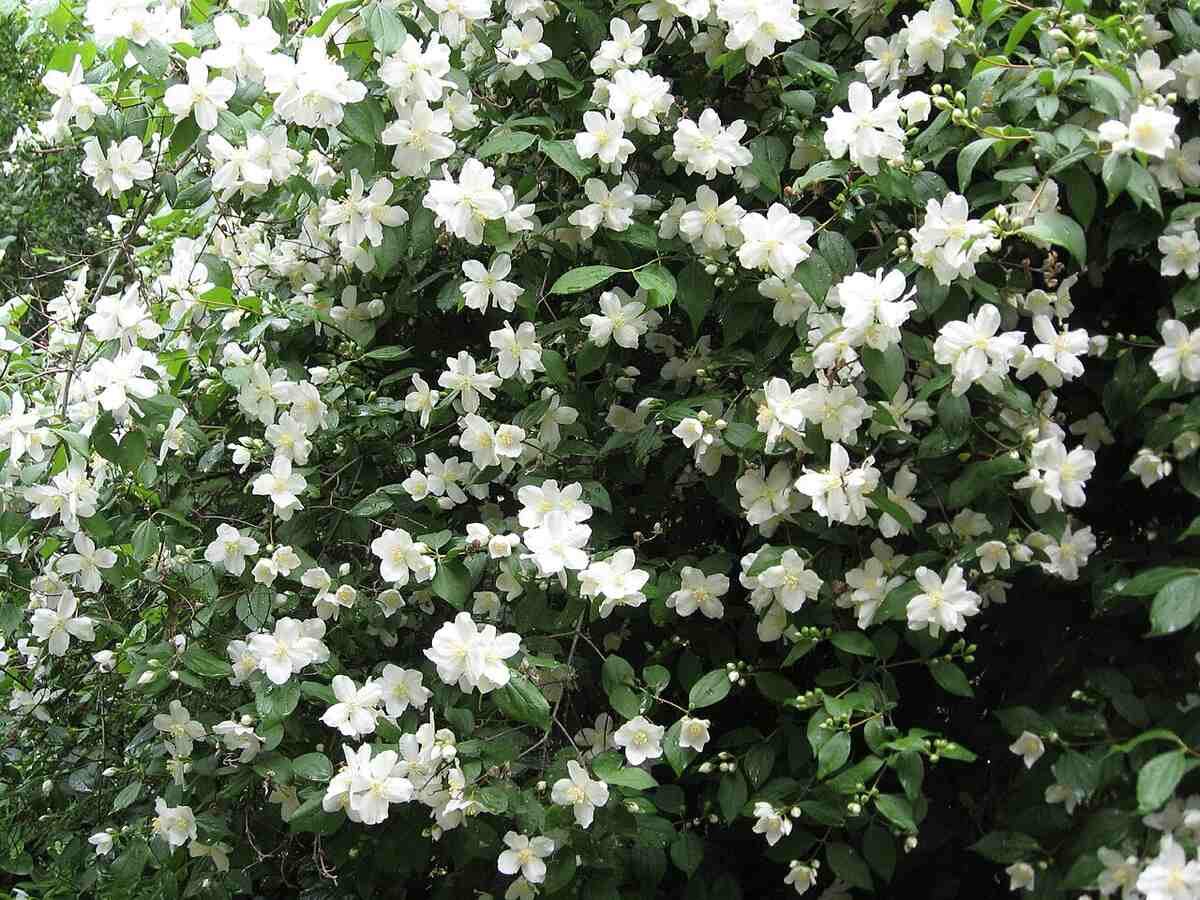
Residents of Washington are fortunate to have a vast selection of flora that thrive in the local climate and soil conditions and perfectly complement landscapes. However, selecting the best Washington native plants is not just about creating a stunning garden but about contributing to the preservation of entire ecosystems.
So, whether you’re a gardening enthusiast in Seattle or a nature lover near the tranquil shores of Puget Sound, get ready to go native and bring a touch of Washington’s natural beauty into your own backyard.
What is a Native Plant?
Native plants naturally grow in a specific area without any human help. They have been there for a long time, evolving and adapting to the local environment. As a result, these plants are well-suited to the climate, soil, and other conditions of their native region.
In Washington, it doesn’t matter if you’re facing the western region’s rainy winters and dry summers or the varying temperatures of the eastern region, with hot summers and cold winters — native plants are adapted to it, making them the ultimate choice for your landscape.
So let’s embark on this gardening journey in Washington using this curated native plants list.
Washington Native Flowers
Common Yarrow (Achillea millefolium)
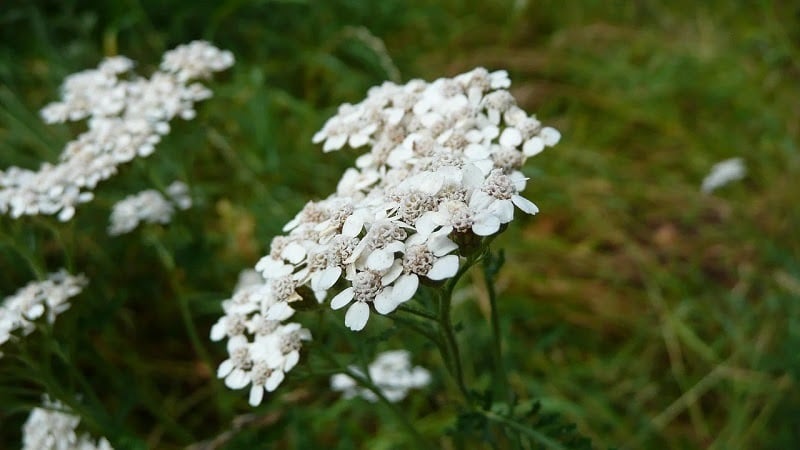
Common yarrow is a captivating plant known for its clusters of creamy white flowers. These delicate blooms form large clusters atop tall stems above the fern-like foliage. Not only are these flowers visually appealing, but they also attract butterflies.
To prolong the bloom season, removing the faded flowers through a process known as deadheading is recommended.
- Plant type: Wildflower
- USDA Hardiness Zone: 4 – 8
- Sun: Full sun to partial shade
- Soil: Well-drained soil, prefers sandy loams
- Duration: Perennial
- Foliage: Evergreen
- Bloom time: April to September
- Water needs: Moderate
- Mature height: Up to 3 feet
- Potential hazards: Continuous ingestion may cause a skin rash.
- Region: Most of temperate North America
Common Camas (Camassia quamash)
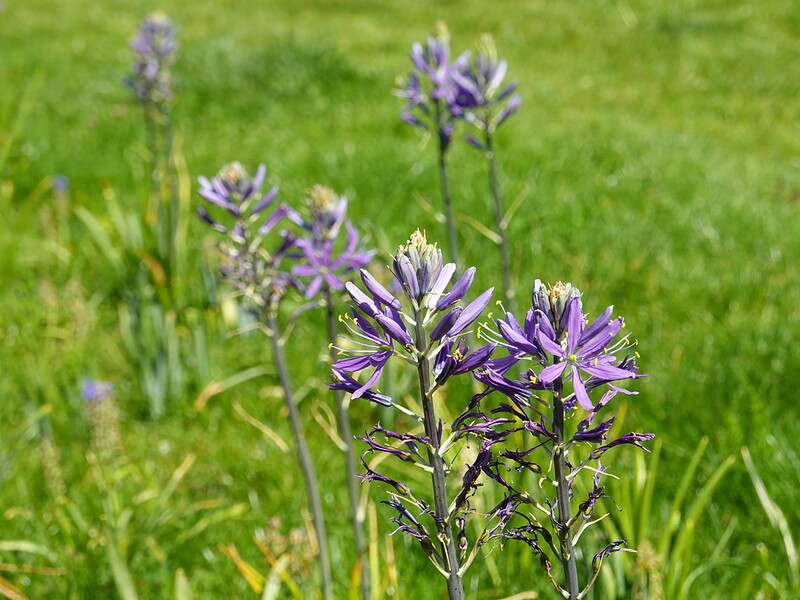
The camas is a bulbous perennial that features star-shaped blue flowers with bright yellow stamens, which create a charming contrast. These blooms attract bumblebees and other pollinators, making them an essential addition to any garden. The camas also showcase grass-like, bright green leaves that complement their appearance.
- Plant type: Wildflower
- USDA Hardiness Zone: 4 – 8
- Sun: Full sun to partial shade
- Soil: Fertile, humus-rich, moist, well-drained soils
- Duration: Perennial
- Foliage: Deciduous
- Bloom time: April – June
- Water needs: Moderate
- Mature height: Up to 3 feet
- Region: British Columbia to California
Red Columbine (Aquilegia formosa)
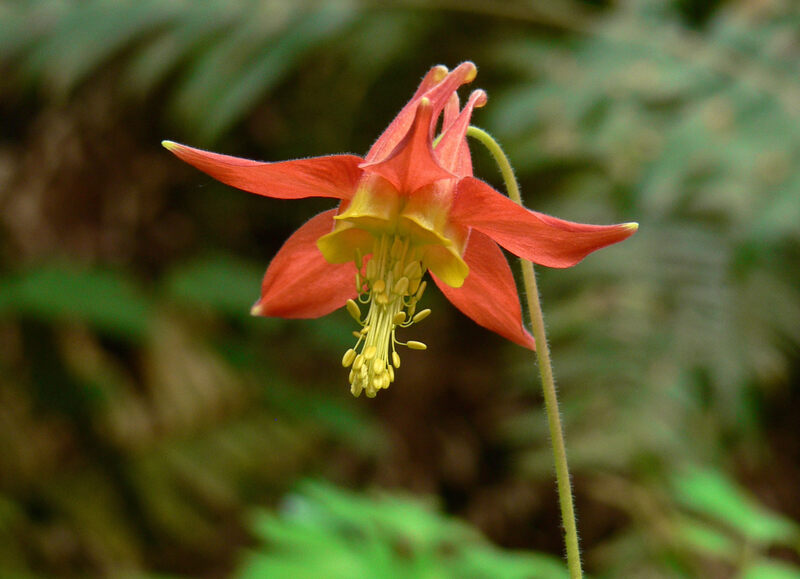
The red columbine (Aquilegia formosa) is a stunning plant known for its pendant-shaped flowers in shades of red and yellow. The flowers feature bushy golden stamens that create a beautiful contrast to the petals. Although each plant has a short lifespan, it compensates by self-seeding, ensuring that new plants will emerge and continue the cycle of beauty.
- Plant type: Wildflower
- USDA Hardiness Zone: 3 – 9
- Sun: Full sun to partial shade
- Soil: Chalky, clay, loamy, or sandy soil that’s well-drained and nutrient-rich
- Duration: Perennial
- Foliage: Deciduous
- Bloom time: April to August
- Water needs: Moderate
- Mature height: 1 – 3 feet
- Potential hazards: Contains toxins that can cause stomach issues or heart palpitations
- Region: From Alaska to Baja California, and eastward to Montana and Wyoming
Pacific Bleeding Heart (Dicentra formosa)
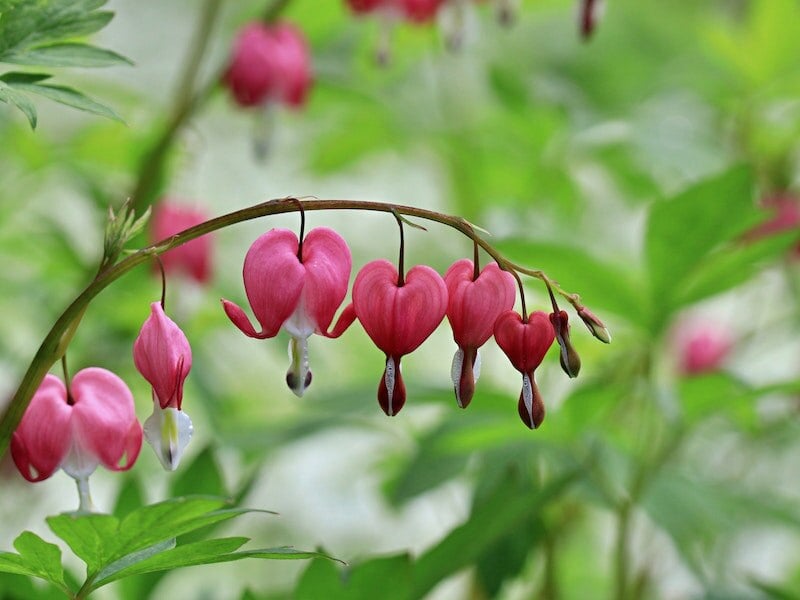
The Pacific bleeding heart is an adorable plant with unique, heart-shaped pink flowers. These charming blooms dangle gracefully above the fern-like foliage, adding a delicate touch to the overall appearance.
However, this wildflower’s beauty hides a secret — it’s toxic! So, it’s best to avoid it if you have little ones running around or mischievous pets with a knack for nibbling on everything green.
- Plant type: Wildflower
- USDA Hardiness Zone: 3 – 9
- Sun: Thrives in partial shade, tolerates full sun and full shade
- Soil: Moist, well-drained, humus-rich soil
- Duration: Perennial
- Foliage: Deciduous
- Bloom time: March to September
- Water needs: Low to moderate
- Mature height: 1 – 2 feet
- Potential hazards: Toxic to humans and animals. Causes sickness when ingested and is a possible skin irritant.
- Region: Pacific Coast
Washington Native Shrubs
Western Serviceberry (Amelanchier alnifolia)
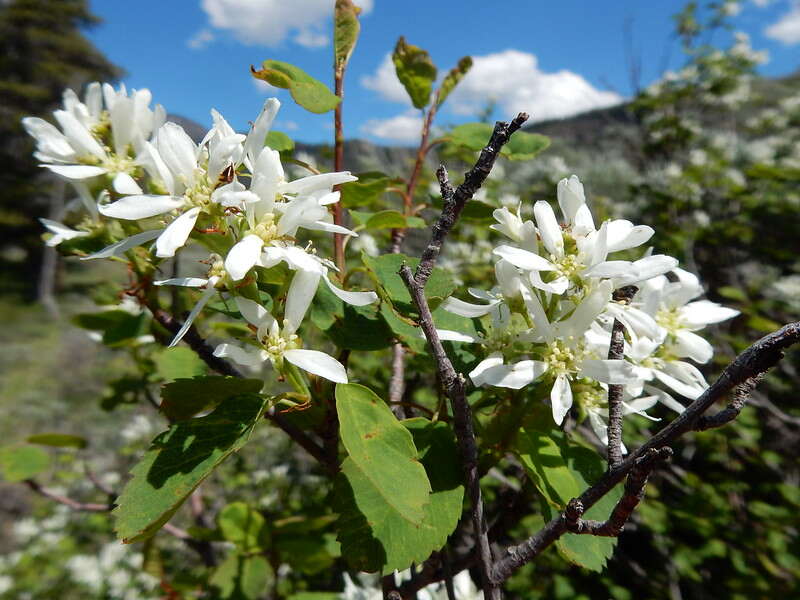
The Western Serviceberry is a versatile plant that can be either a shrub or a small tree. In early spring, it displays delicate white flowers that later give way to clusters of purple berries. These berries are visually appealing and edible, offering a tasty treat for both humans and wildlife.
- Plant type: Shrub or small tree
- USDA Hardiness Zone: 4 – 9
- Sun: Full sun to partial shade
- Soil: Loamy or sandy, well-drained
- Duration: Perennial
- Foliage: Deciduous
- Bloom time: April, May, June
- Water needs: Low
- Mature height: 3 – 16 feet
- Region: From Alaska to California, and across the Great Plains
Red Flowering Currant (Ribes sanguineum)
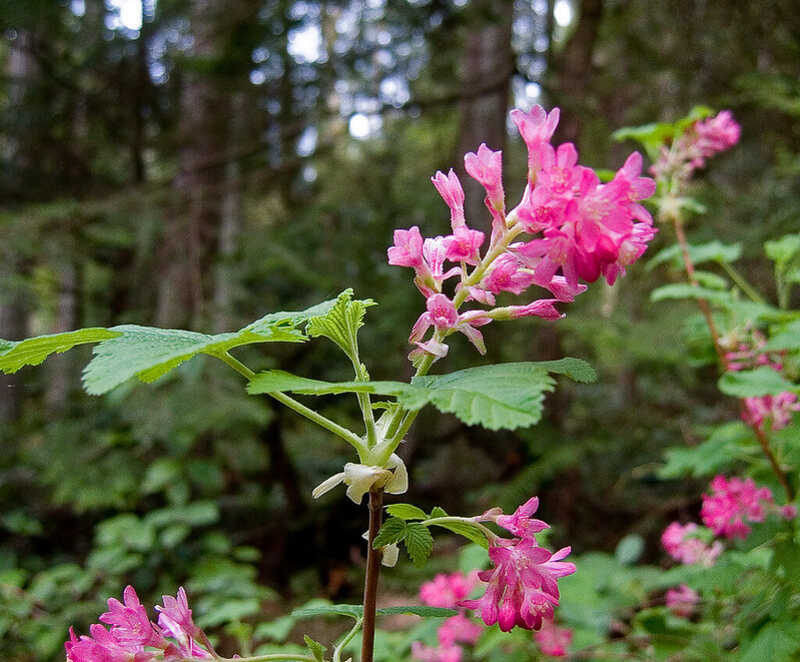
The red flowering currant captures attention with its distinctive features. Its drooping magenta flowers are impossible to ignore and have a special allure that draws hummingbirds to the nectar-filled blossoms. After the flowering season, the plant produces small blue-black berries coated with a delicate, thin layer of white wax.
- Plant type: Flowering shrub
- USDA Hardiness Zone: 6 – 8
- Sun: Full sun to partial shade
- Soil: Can tolerate most soils but prefers well-drained, moist soils
- Duration: Perennial
- Foliage: Deciduous
- Bloom time: January to July
- Water needs: Moderate
- Mature height: 5 – 12 feet
- Region: Coastal California to British Columbia
Tall Oregon Grape (Mahonia aquifolium)
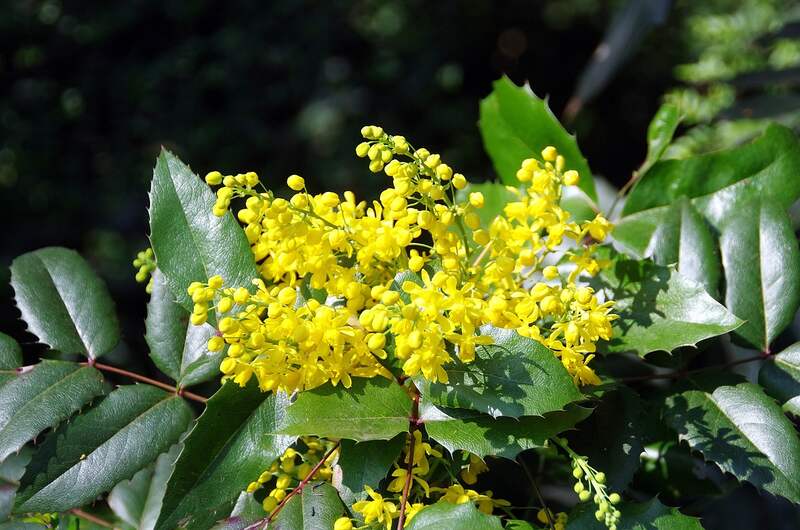
The Oregon grape is a plant that knows how to put on a colorful show. In spring, it flaunts clusters of bright yellow flowers. As the seasons change, they transform into clusters of dark blue-purple berries. If you like making jellies, this shrub will be a fruitful source for your homemade creations.
- Plant type: Flowering shrub
- USDA Hardiness Zone: 5 – 9
- Sun: Full sun to shade
- Soil: Prefers rich, well-drained soils
- Duration: Perennial
- Foliage: Evergreen
- Bloom time: March to June
- Water needs: Low
- Mature height: Up to 6 feet
- Region: Northern California to the Pacific Northwest
Mock Orange (Philadelphus lewisii)
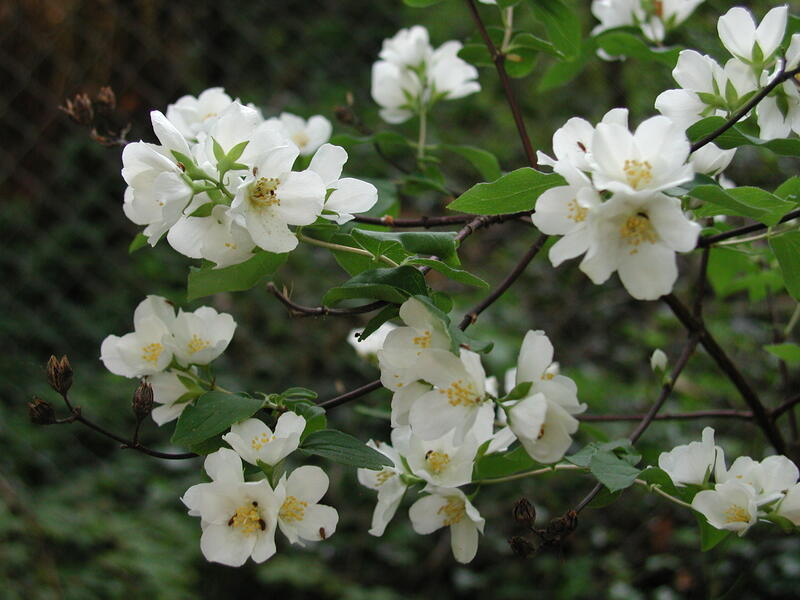
The mock orange is a shrub with long, arching stems that are a sight to behold, especially in late spring when they burst into elegant cup-shaped white flowers. These delicate blooms release a sweet fragrance reminiscent of orange blossoms, enveloping the surrounding area with their delightful scent.
- Plant type: Flowering shrub
- USDA Hardiness Zone: 3 – 8
- Sun: Full sun to partial shade
- Soil: Grows well in various soils, from heavy clay to sandy
- Duration: Perennial
- Foliage: Deciduous
- Bloom time: March to July
- Water needs: Low
- Mature height: Up to 12 feet
- Potential hazards: Can cause irritation to sensitive skin
- Region: British Columbia to central California, and Montana
Red Elderberry (Sambucus racemosa)
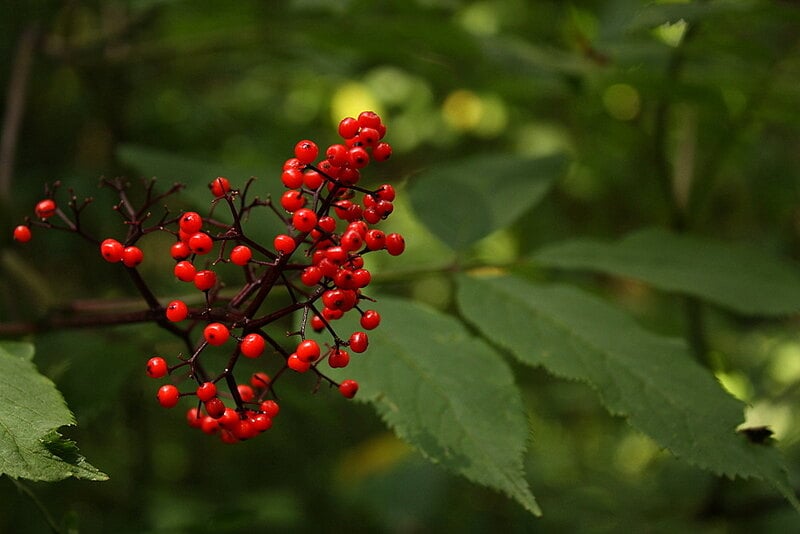
The red elderberry is a sizable shrub that brings interest to the garden from spring through fall. It showcases conical clusters of white flowers during late spring to early summer. Then, clusters of red berries emerge during the fall, creating a feast for the eyes and a treat for hummingbirds and butterflies.
The red elderberry is visually pleasing and easy to grow, making it a popular choice for garden enthusiasts in the Pacific Northwest.
- Plant type: Shrub
- USDA Hardiness Zone: 3 – 7
- Sun: Full sun to partial shade
- Soil: Moist and well-drained
- Duration: Perennial
- Foliage: Deciduous
- Bloom time: May, June
- Water needs: Moderate
- Mature height: 8 – 20 feet
- Potential hazards: Seeds are poisonous; raw berries are toxic
- Region: Found throughout most of the states, including Washington
Vine Maple (Acer circinatum)
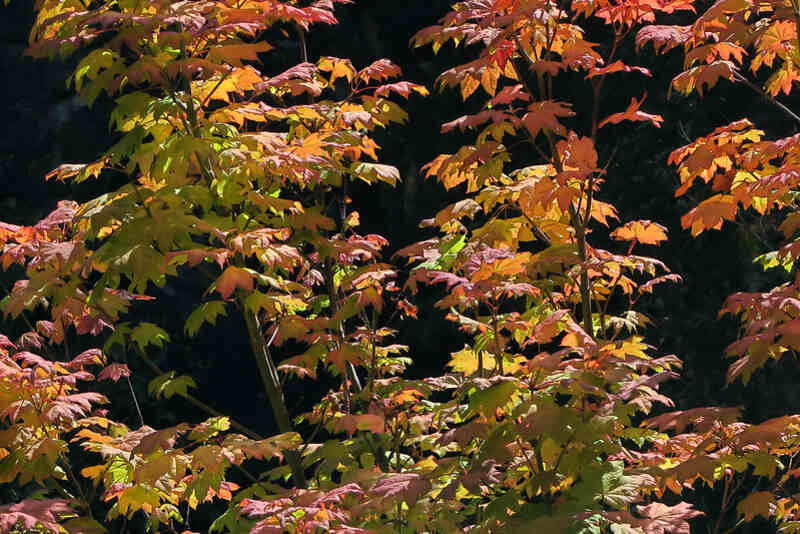
The vine maple can be a large shrub or, occasionally, a small to medium-sized tree. Its leaves undergo a remarkable transformation throughout the seasons, starting with bright green hues in the spring and gradually transitioning to captivating shades of red and orange in the fall.
In the spring, the vine maple also graces us with delicate white flowers, which later give way to eye-catching red-winged fruits.
- Plant type: Shrub or small tree
- USDA Hardiness Zone: 5 – 9
- Sun: Partial shade
- Soil: Loam, sand, clay, moist, well-drained soil
- Duration: Perennial
- Foliage: Deciduous
- Bloom time: March, April, May
- Water needs: Moderate
- Mature height: 15 – 30 feet
- Region: Not ideal for eastern Washington, more common west of the Cascades
Washington Native Trees
Douglas-Fir (Pseudotsuga menziesii)
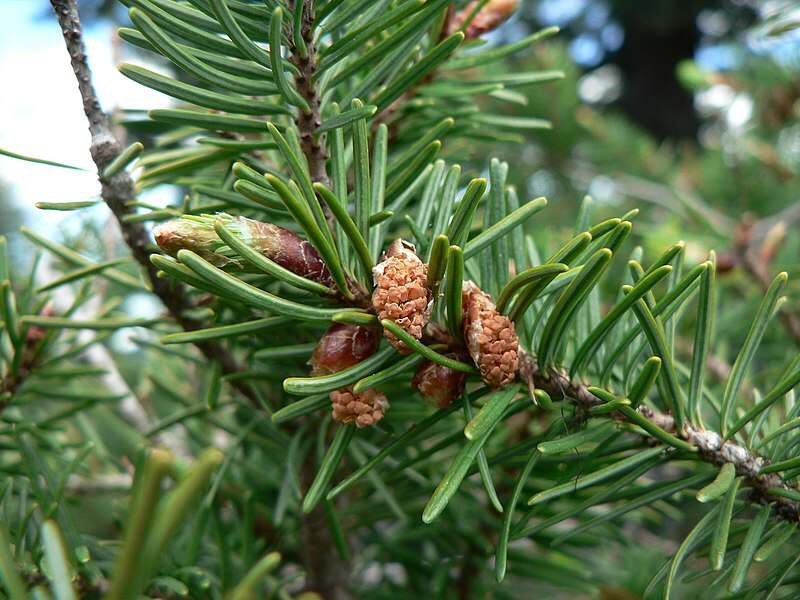
The Douglas-fir is a majestic conifer tree that commands attention in the forest. Its deep green or blue-green needles create a striking color palette that adds beauty to the landscape. The tree produces pendant cones with forked bracts, resembling Christmas ornaments hanging delicately from its branches.
- Plant type: Tree
- USDA Hardiness Zone: 4-6
- Sun: Full sun to partial shade
- Soil: Tolerates a wide range of soils, including igneous and limestone-based
- Duration: Perennial
- Foliage: Evergreen
- Bloom time: April
- Water needs: Moderate
- Mature height: 75-150 feet
- Potential hazards: Beware of power lines
- Region: Various regions in the West
Pacific Dogwood (Cornus nuttallii)
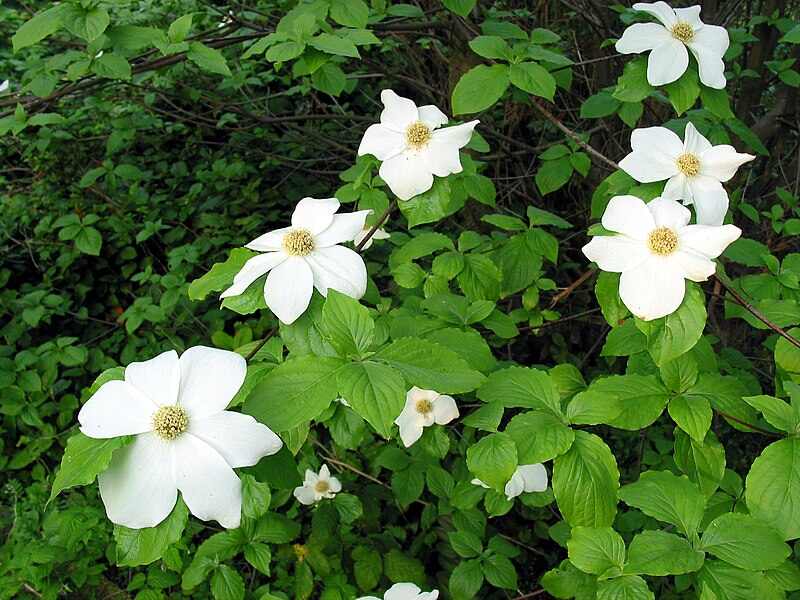
The Pacific dogwood is a majestic native ornamental tree found along the Pacific Coast. The branches are adorned with creamy white blossoms from mid-spring to mid-summer, creating a stunning display. These blossoms eventually transform into rounded, orange-red fruits that emerge in the summer.
- Plant type: Shrub or tree
- USDA Hardiness Zone: 7 – 9
- Sun: Full sun to partial shade
- Soil: Moist and well-drained clay soil, with high organic matter
- Duration: Perennial
- Foliage: Deciduous
- Bloom time: April – July
- Water needs: Moderate
- Mature height: Up to 60 feet
- Region: From southern British Columbia to southern California and central Idaho
Western Hemlock (Tsuga heterophylla)
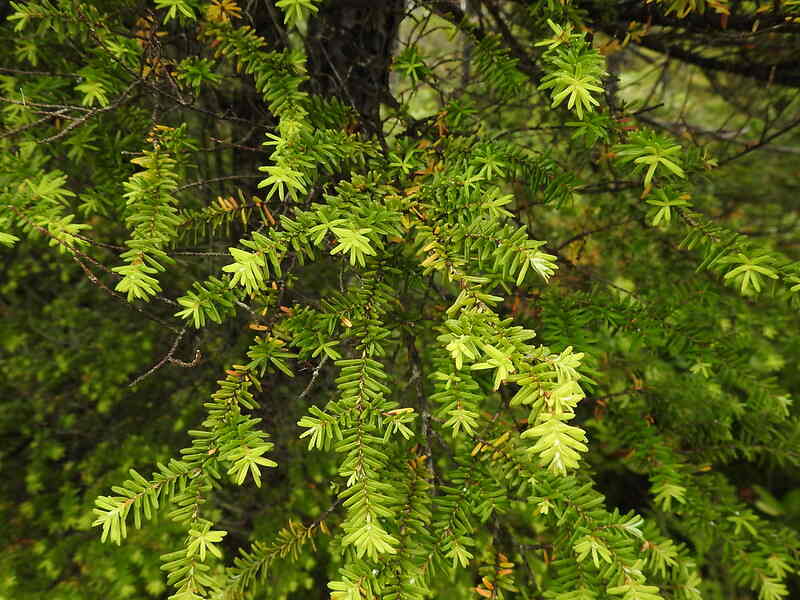
The western hemlock is a conifer that reaches great heights, adding an impressive vertical presence to the forest. Delicate and feathery needles characterize its foliage. As the tree matures, small seed cones develop and gradually turn brown.
The western hemlock’s understated beauty lies in its simplicity and natural elegance, showcasing the coniferous species’ quiet strength and timeless charm.
- Plant type: Tree
- USDA Hardiness Zone: 6
- Sun: Full sun to partial shade
- Soil: Moist to mesic soils
- Duration: Perennial
- Foliage: Evergreen
- Bloom time: April
- Water needs: Moderate
- Mature height: Up to 200 feet
- Region: Pacific Northwest’s coast
Western Red Cedar (Thuja plicata)
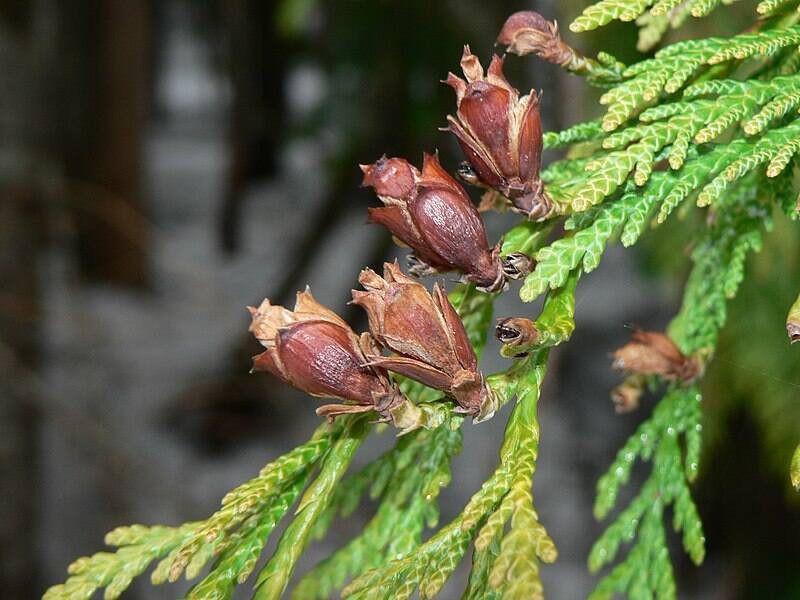
The Western red cedar is a slender, pyramidal tree typically reaching 50 to 75 feet. One notable characteristic of this tree is the fragrance emitted by its foliage, which brings a delightful aroma to the surrounding area. This tree is also known for its durability and rot-resistant properties.
- Plant type: Tree
- USDA Hardiness Zone: 5 – 8
- Sun: Full sun to partial shade
- Soil: Prefers moist, slightly acidic soils
- Duration: Perennial
- Foliage: Evergreen
- Bloom time: April
- Water needs: Moderate
- Mature height: Up to 200 feet
- Potential hazards: Must be careful with power lines above it.
- Region: Pacific Coast, including western Washington, western Oregon, and northern California. It’s also present in a section east of the Cascade Range from central Oregon to southern British Columbia.
Grand Fir (Abies grandis)
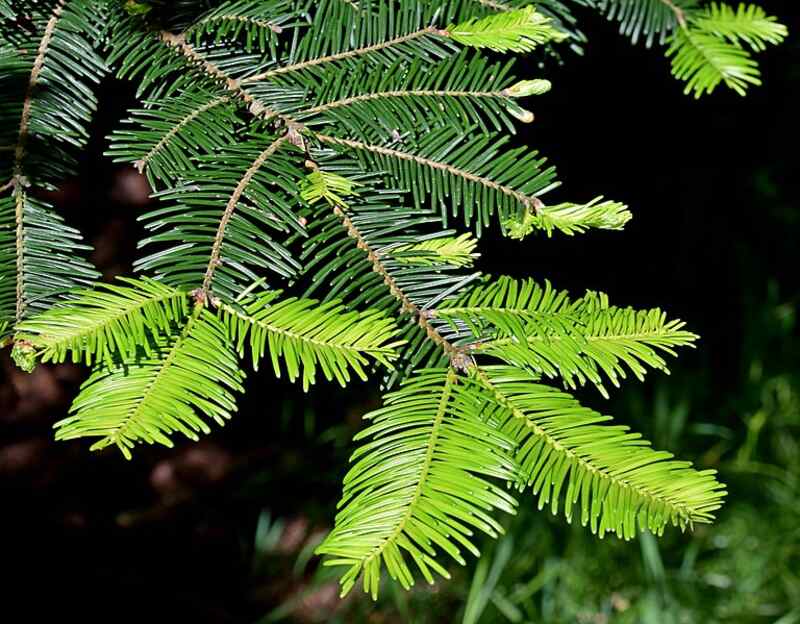
The grand fir is a coniferous tree that stands tall and proud in the forest. Its branches are densely covered with sharp-tipped needles in a deep green hue. This tree grows fast, allowing it to reach impressive heights relatively quickly.
Additionally, the grand fir does not require much pruning, making it a low-maintenance choice for those seeking a hassle-free addition to their landscapes.
- Plant type: Tree
- USDA Hardiness Zone: 5 – 6
- Sun: Partial shade
- Soil: Well-drained soils
- Duration: Perennial
- Foliage: Evergreen
- Bloom time: April, May
- Water needs: Moderate
- Mature height: More than 200 feet
- Potential hazards: Susceptible to wildfires
- Region: Southern British Columbia to California, also in central Idaho and eastern Oregon
Red Alder (Alnus rubra)
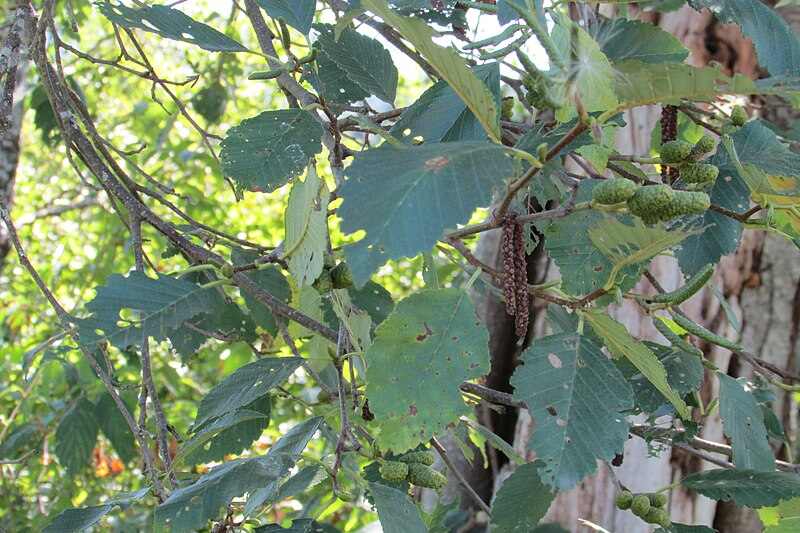
The red alder is a medium-sized tree with distinctive features. When the wood is bruised, it turns a rusty red color, giving the tree its name. In mid-spring, catkins hang from the branches, releasing pollen that attracts bees and other pollinators.
The red alder showcases nature’s clever design and is vital in supporting pollination and biodiversity.
- Plant type: Tree
- USDA Hardiness Zone: 7 – 9
- Sun: Full sun, partial shade
- Soil: Prefers moist, mineral soil
- Duration: Perennial
- Foliage: Deciduous
- Bloom time: March – April
- Water needs: High
- Mature height: 40 – 80 feet
- Region: Pacific Coast, from southeast Alaska to southern California
Sitka Spruce (Picea sitchensis)
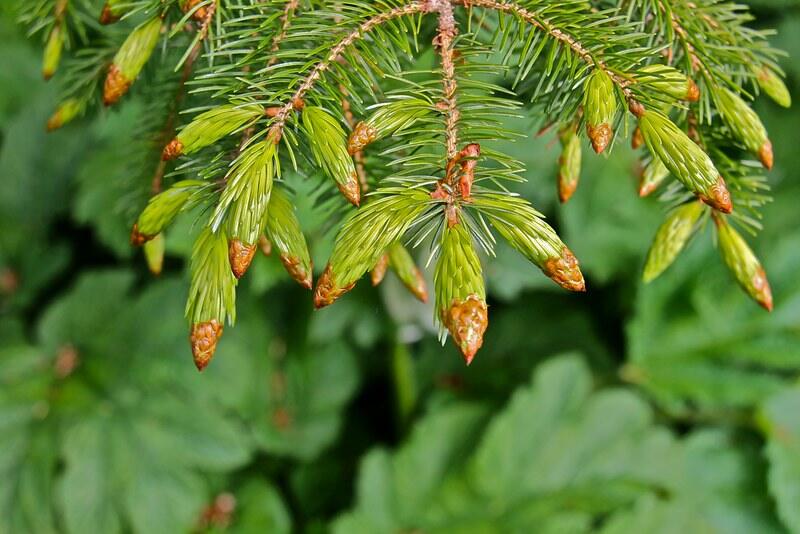
The Sitka spruce (Picea sitchensis) is a hardy conifer with a distinctive conical crown. Its flat, prickly needles contribute to its unique appearance. This tree is renowned for its rapid growth, making it one of the world’s fastest-growing trees. In addition, it is resilient, tolerating strong winds and salt spray.
- Plant type: Tree
- USDA Hardiness Zone: 4 – 9
- Sun: Sun to partial shade
- Soil: Moist to wet soils
- Duration: Perennial
- Foliage: Evergreen
- Bloom time: April, May
- Water needs: Moderate
- Mature height: 50 – 100 feet
- Region: Pacific Coast
How to Choose Native Plants for Washington
When selecting native plants for your Washington landscape, there are a few key factors to keep in mind.
First, consider whether you are in western or eastern Washington, as these regions have climate differences.
Second, the amount of shade present in your landscape. Some native plants in Washington thrive in full sun, while others prefer partial or full shade, so make an informed decision.
Lastly, think about the level of maintenance you are willing to undertake. Native plants vary in their growth habits, with some requiring minimal care while others may need regular pruning or attention.
FAQ About Native Plants
The state flower of Washington is the coast rhododendron (Rhododendron macrophyllum). This beautiful flower is known for its vibrant pink to lavender petals and large, showy clusters. It is commonly found in Washington’s coastal regions and lowland forests, adding a splash of color to the landscape in late spring and early summer.
The state tree of Washington is the western hemlock (Tsuga heterophylla). This evergreen conifer is an iconic symbol of the state’s lush forests and natural beauty, playing a vital role in the ecosystem and serving as a testament to the rich biodiversity in the Evergreen State.
Washington is blessed with a wide range of soil types, offering diverse conditions for plant growth across the state.
One notable soil in Washington is the official state soil called Tokul, named after a creek community in King County. Tokul soil is known for its richness and productivity, providing a fertile foundation for the growth of magnificent cedars and firs.
Bring In the Pros
By embracing and incorporating native plants into our Washington gardens and landscapes, we create visually captivating spaces and contribute to preserving our natural heritage.
So why not call a Washington landscaping pro near you? We have trusted professionals in Seattle, Spokane, Tacoma, and many more cities across the state.
Main Image Credit: A.Barra / Wikimedia Commons / CC BY-SA 4.0